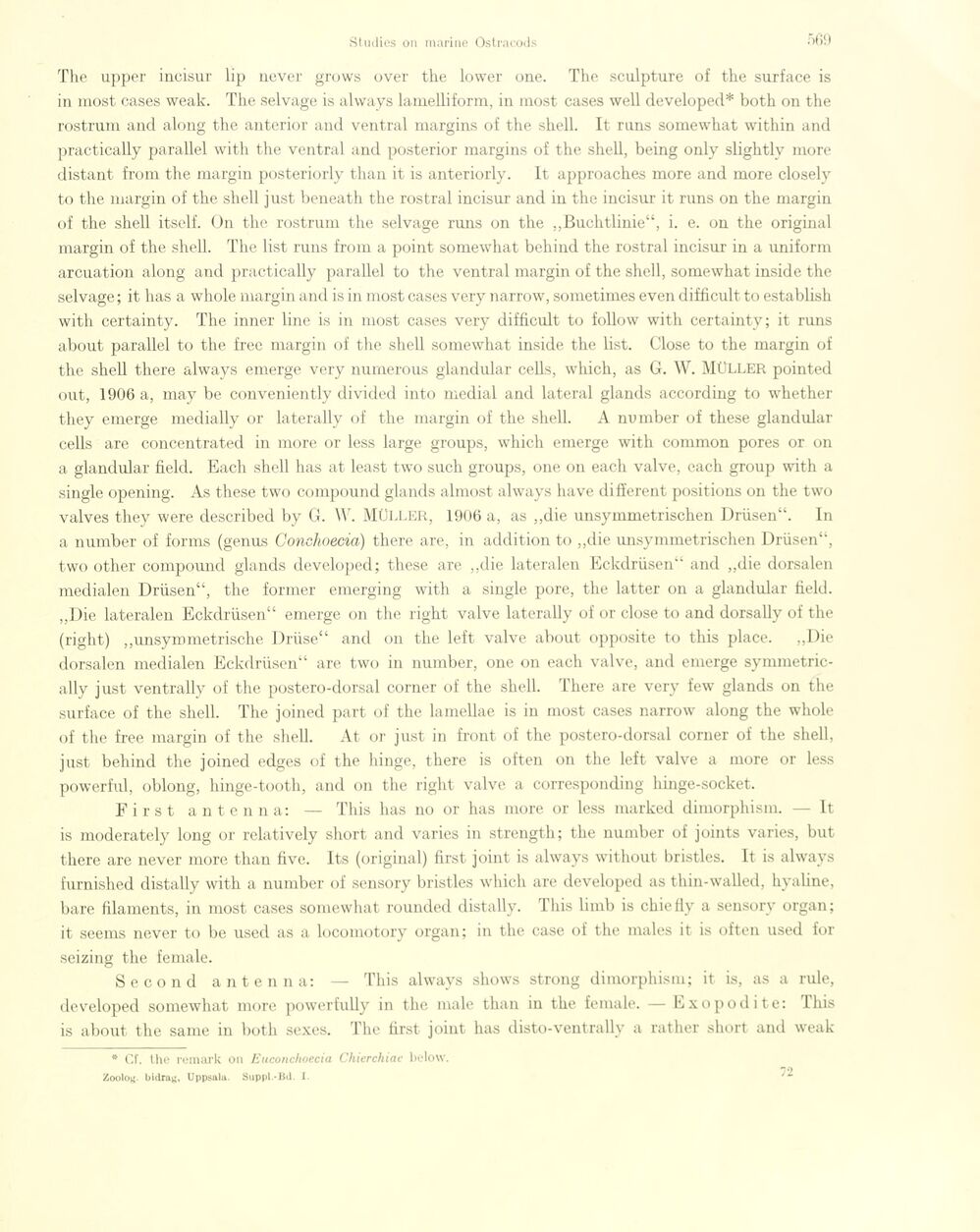
Full resolution (JPEG) - On this page / på denna sida - Sidor ...

<< prev. page << föreg. sida << >> nästa sida >> next page >>
Below is the raw OCR text
from the above scanned image.
Do you see an error? Proofread the page now!
Här nedan syns maskintolkade texten från faksimilbilden ovan.
Ser du något fel? Korrekturläs sidan nu!
This page has never been proofread. / Denna sida har aldrig korrekturlästs.
The upper incisur lip never grows over the lower one. The sculpture of the surface is
in most cases weak. The selvage is always lamelliform, in most cases well developed* both on the
rostrum and along the anterior and ventral margins of the shell. It runs somewhat within and
practically parallel with the ventral and posterior margins of the shell, being only slightlv more
distant from the margin posteriorly than it is anteriorly. It approaches more and more closely
to the margin of the shell just beneath the rostral incisur and in the incisur it runs on the margin
of the shell itself. On the rostrum the selvage runs on the „Buchtlinie“, i. e. on the original
margin of the shell. The list runs from a point somewhat behind the rostral incisur in a uniform
arcuation along and practically parallel to the ventral margin of the shell, somewhat inside the
selvage; it has a whole margin and is in most cases very narrow, sometimes even difficult to establish
with certainty. The inner line is in most cases very difficult to follow with certainty; it runs
about parallel to the free margin of the shell somewhat inside the list. Close to the margin of
the shell there always emerge very numerous glandular cells, which, as G. W. Müller pointed
out, 1906 a, may be conveniently divided into medial and latéral glands according to whether
they emerge medially or laterally of the margin of the shell. A number of these glandular
cells are concentrated in more or less large groups, which emerge with common pores or on
a glandular field. Each shell has at least two such groups, one on each valve, each group with a
single opening. As these two compound glands almost always have different positions on the two
valves they were described by G. \V. Müller, 1906 a, as „die unsymmetrischen Drüsen“, ln
a number of forms (genus Conchoecia) there are, in addition to „die unsymmetrischen Drüsen“,
two other compound glands developed; these are „die lateralen Eckdrüsen“ and „die dorsalen
medialen Drüsen“, the former emerging with a single pore, the latter on a glandular field.
„Die lateralen Eckdrüsen“ emerge on the right valve laterally of or close to and dorsally of the
(right) „unsymmetrische Drüse“ and on the left valve about opposite to this place. „Die
dorsalen medialen Eckdrüsen“ are two in number, one on each valve, and emerge
symmetric-ally just ventrally of the postero-dorsal corner of the shell. There are very few glands on the
surface of the shell. The joined part of the lamellae is in most cases narrow along the whole
of the free margin of the shell. At or just in front of the postero-dorsal corner of the shell,
just behind the joined edges of the hinge, there is often on the left valve a more or less
powerfiü, oblong, hinge-tooth, and on the right valve a corresponding hinge-socket.
First antenna: — This has no or has more or less marked dimorphism. — It
is moderately long or relatively short and varies in strength; the number of joints varies, but
there are never more than five. Its (original) first joint is always without bristles. It is always
furnished distally with a number of sensory bristles which are developed as thin-walled, hyaline,
bare filaments, in most cases somewhat rounded distally. This limb is chieüy a sensory organ;
it seems never to be used as a locomotory organ; in the case of the males it is often used for
seizing the female.
Second antenna: — This always shows strong dimorphism; it is, as a rule,
developed somewhat more powerfully in the male than in the female. — Exopodite: This
is about the saine in both sexes. The first joint has disto-ventrally a rather short and weak
* Cf. the remark on Euconchoccia Chierchiae below.
Zoolog, bidrag, Uppsala. Suppl.-Bd. I
<< prev. page << föreg. sida << >> nästa sida >> next page >>